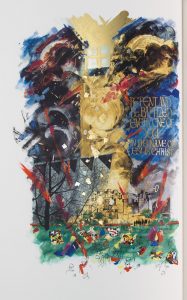
For believers, Pentecost is the time in which the Holy Spirit descended upon the Apostles and Mary fifty days after the resurrection. Others will add that Pentecost is also the birthday of the Church. Pentecost or Shavu’ot is also a traditional Jewish feast which remembers the day when Moses received the law from God.
The image that is displayed is based on the event described in the Acts of the Apostles. This image is quite different from traditional images we see of Pentecost; this seems to be a darker image that does not depict the Apostles and Mary in a room looking towards heaven with tongues of fire above their heads.
Susan Sink explains the darker imagery in The Art of the Saint John’s Bible:
Much of the imagery comes from the prophecy of Joel describing the day of the Lord with all its traditional imagery: blood, fire, smoky mists, and heavenly portents, to which Peter refers in his speech. However, in this scene the Lukan author shows the Day of the Lord as hopeful, a fulfillment and building up, not as one of destruction.” (Vol. 1., p. 101)
Sink also reminds the reader of the image’s connections, which are alluded to in the lower half of the illumination:
This illumination joins the past and the present, Jerusalem and the Abbey Church in Collegeville, to show the scope of the ministry of the Church.
From this event the Apostles went forth to evangelize all peoples and nations. Through this event the ministry of the Church began, not with people of status and fame but with ordinary people. As you look at this image, reflect on Sink’s words: “The hope of the passage, and of the illumination, is life in the Holy Spirit in history and eternity.” (Ibid.) So the ministry of the Church continues.
This commentary was contributed by James Gumataotao, a senior Theology major and a member of the Library’s Research Desk team.